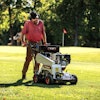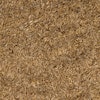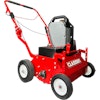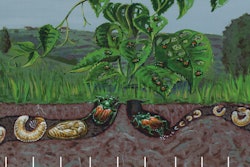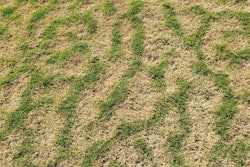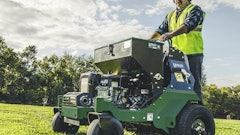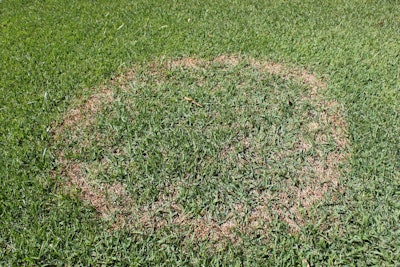
The spring season quickly came upon us, and it’s just as quickly coming to an end. As we transition into warmer summer temperatures, both warm- and cool-season turfgrasses experience heat stress more than any other time of the year. The likelihood of disease outbreaks in warm-season grasses starts to decrease while opportunities in cool-season grasses increase. Cool-season grasses that grow in the northern two-thirds of the United States include Kentucky bluegrass, annual and perennial ryegrass, fescue and bentgrass.
A basic understanding of how turfgrass diseases work and what causes them is essential in any disease prevention or treatment strategy.
About cool-season turfgrass disease
Diseases require three things also known as the disease triangle:
- A host, which is the turfgrass.
- A pathogen that is always present in the grass, thatch layer and soil. These pathogens remain in a state of dormancy until weather conditions trigger them to spread.
- The ideal environmental conditions matter because they play a major role in how the pathogens spread.
As previously stated, a turfgrass disease can take hold at any point in the year although unlikely during some periods or seasons depending on the type of disease.
All types of turfgrasses are at their most vulnerable to diseases when the grass is growing slowly, damaged or stressed. Cool-season grasses in particular grow the slowest during the summer season and go into a state of dormancy to survive hot or dry summer periods or even during the winter. This is a method of preservation when environments are too stressful.
On the other hand, the spring and fall seasons, which are two transitional periods between the hottest and coldest times of the year, are the opportune times for disease outbreaks in warm-season grasses. During this change when the weather isn’t overly hot or cold combined with humidity, excessive irrigation and nitrogen inputs, opportune environments for disease outbreaks are created.
Methods of cultural prevention
Searching for the right fungicide as a chemical treatment or prevention strategy can be really effective but there are still a few cultural tasks to perform. Before making applications of anything for prevention, being cognizant of the cultural prevention methods for turfgrass disease serves as a major line of defense.
Lawns that are properly fed, watered in mornings, mowed at the right height, regularly aerated and dethatched, have access to light, and are located in places with airflow are more likely to better resist disease outbreaks and successfully fight off disease when infected. Some common tips for cultural prevention are listed below:
● When mowing, make sure the mower blade is sharp and that the grass is being mowed at its appropriate, grass-specific height. Never remove more than a third of the leaf blade at one time.
● Provide the lawn with the right amount of irrigation. Overwatering can create water-logged soils which are an ideal environment for disease outbreaks especially combined with shade. Most lawns only need 1-inch of water a week including rainfall.
● Too much nitrogen fertilizer can be a recipe for disaster. Collect and submit a soil analysis to find out which nutrients the lawn actually needs before making any applications.
Common summer turfgrass diseases
- Brown patch is a more common turfgrass disease that can affect all cool-season grasses and usually begins appearing in mid to late summer when the weather is warm and humid. Brown patch creates thin circular patches of brown grass that can vary in size and pattern. The disease can sometimes appear in circular shapes as well as irregular shapes. The color of the dead or affected grass varies from brown, tan and yellow, and sometimes there is a border of dark grass surrounding the damaged area.
Preventive and curative fungicides should contain one or more of the following active ingredients: azoxystrobin, chlorothalonil, fludioxonil, flutolanil, iprodione, Junction, mancozeb, metconazole, myclobutanil, polyoxin D, propiconazole, pyraclostrobin, thiophanate-methyl, thiram, triadimefon, trifloxystrobin, triticonazole or vinclozolin. Brown patchSod Solutions
Brown patchSod Solutions
- Pythium blight is a disease that mostly affects cool-season grasses but can also sometimes be found in bermudagrasses. This disease typically shows up when temperatures are warming up in the late spring and early summer seasons. When grass is affected by pythium blight, large dark-gray patches start to appear. Sometimes the grass blades will have a fine, greasy layer coating. As the disease continues to grow, the grass will change to a brown or tan color because it’s dead. Lastly a cottonlike substance called mycelium can sometimes be spotted with this disease.
When searching for the best disease control for pythium blight, there are many options to consider. For best results, consider using one or more of the following active ingredients: azoxystrobin, propiconazole, chlorothalonil, fluoxastrobin, mefenoxam, propamocarb, cyazofamid or fluopicolide.
- Summer patch, or Magnaporthiopsis poae, presents a circular or ringlike pattern that can range from .5 foot to 3 feet in diameter. Most of the time, the affected turf is discolored and sunken. It can also have an orange border surrounding the edges of the affected area. Summer patch can affect cool-season grasses including bluegrass, annual bluegrass, tall fescue and bentgrass. This turfgrass disease affects grasses in the summer.
The best active ingredients for summer patch are: azoxystrobin, fluoxastrobin, flutriafol, fluxapyroxad, mefentrifluconazole, metconazole, myclobutanil, penthiopyrad, propiconazole, prothioconazole, pyraclostrobin, tebuconazole, thiophanate-methyl, triadimefon, trifloxystrobin or triticonazole.
- Dollar spot is a common turfgrass disease that can be found in both warm- and cool-season grasses with the most common ones being bermudagrass, ryegrass and Kentucky bluegrass. Dollar spot, as its name suggests, appears as little circular areas of discolored, damaged or dead turfgrass that oftentimes takes the shape of a silver dollar. They can grow up to 6 inches in diameter. This disease takes hold of turfgrasses between mid-May and mid-October.
Fungicides with chlorothalonil, fluoxastrobin or azoxystrobin are the most recommended solutions for treatment and prevention of dollar spot.
- Fairy ring is another common disease found in all types of warm- and cool-season grasses. This disease typically creates a ring or circular structure with mushrooms and darkened turfgrass. Rainy, warmer weather can sometimes create ideal environments for this disease, and it usually appears around trees, logs or other organic materials.
 Fairy ringSod Solutions
Fairy ringSod Solutions
Unfortunately, an effective fungicide for fairy rings hasn’t been discovered yet. Refer to the list of cultural prevention tips from earlier in this article for the best method of defense.
Finally, another common cool-season turfgrass disease that thrives during the summer months is powdery mildew as it prefers warm, humid weather. The disease lives up to its name in creating a white powdery substance on the surface of grass blades. The turfgrass disease can be found in cool-season grasses including Kentucky bluegrass, fine fescues and perennial ryegrass.
The best fungicides include the active ingredient: metconazole, myclobutanil, propiconazole, tebuconazole, triadimefon or triticonazole. When using any fungicide, be sure to read the product label in its entirety.

